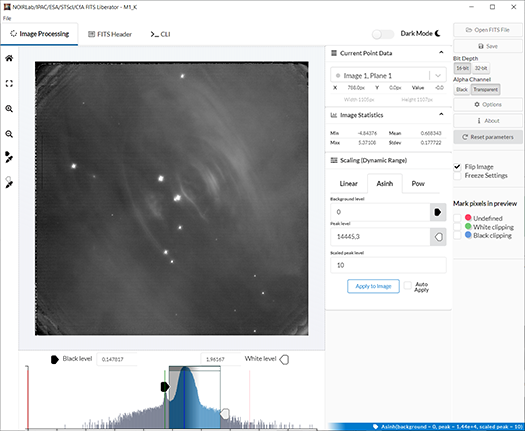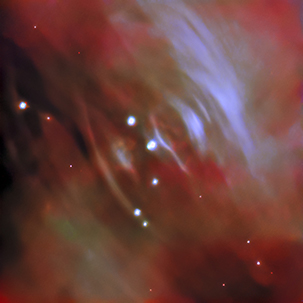Upgrading Our Views of the Universe
How do we image our Universe? There are many different ways of translating information from the cosmos. But in working with scientific data and image processing software, you can create your own astronomy images from FITS files. "FITS," which stands for Flexible Image Transport System, is a digital file format used mainly by astronomers to work with data of cosmic objects. Today, we are happy to help announce an update to the open source FITS Liberator software that can be used to process your own astronomical data. —Kimberly Kowal Arcand (CfA)
Astronomy is predominantly a visual science. However, an important tool is needed to produce breathtaking color images from the observations made with telescopes such as the NASA/ESA Hubble Space Telescope, NASA's Chandra X-ray Observatory, or the telescopes of NSF's NOIRLab at the international Gemini Observatory, Kitt Peak National Observatory, and Cerro Tololo Inter-American Observatory. The key to unlocking those magnificent vistas is specialized image-processing software.
Since its first release in 2004, FITS Liberator has been a popular image-processing tool to help astronomers — and the public — produce beautiful images from observations recorded in the Flexible Image Transport System (FITS) file format commonly used in astronomy. Among image-processing experts this process is known as 'liberation'; the data are converted to an image format that can be edited in standard graphics software. In the process, users have access to powerful tools to manage the high dynamic range intrinsic to astronomical data, to create a final product that captures the full detail — and beauty — of the source material.
An international team [1] recently worked with computer scientists from Enciso Systems to redesign the FITS Liberator image-processing software using modern technologies, such as the full support of 64-bit operating systems and modern libraries for fast processing. The new version, NOIRLab/IPAC/ESA/STScI/CfA FITS Liberator 4, is now being released for MacOS, Windows, and, for the first time, Linux.
"For over 15 years the FITS Liberator, in its many versions, has been my primary tool for extracting the most compelling imagery from astronomical observations that span the electromagnetic spectrum. I'm delighted with the release of this new version giving everyone access to improved functionality, performance, and compatibility." said Robert Hurt, visualization scientist at Caltech/IPAC.
"For us, as a development team, this is a big challenge — FITS Liberator is a great tool, and it is really appreciated by the scientific community and astronomy enthusiasts," said Juan Fajardo of Enciso Systems/BitPointer, who led the software development team and is responsible for the software's core functionality. "The users were expecting a lot from this new version, and we believe we have delivered it."
FITS Liberator 4 brings several useful new features, including a command-line interface that allows for batch processing of images, a much-improved graphical user interface, support for larger files, full-screen support, and much more. The software has been released as open-source code and can be accessed via GitLab.
"For image-processing professionals, the FITS Liberator has become the go-to tool for producing pretty images," said Lars Lindberg Christensen of NSF's NOIRLab. "It is exciting to see this major overhaul concluded. This will give the tool many more years of use."
Some training materials have been developed for the FITS Liberator 4 launch, including a video for beginner users, a video for advanced users, and a tour of the user interface.
Stay tuned, and get ready to liberate the most fascinating out-of-this-world images!
Notes
[1] This work was done through a collaboration between several major astronomical organizations, including NSF's NOIRLab, the Infrared Processing and Analysis Center (IPAC Caltech), the European Space Agency (ESA), the Space Telescope Science Institute (STScI), and the Center for Astrophysics | Harvard & Smithsonian (CfA).
More Information
The team is composed of Juan Fajardo (Enciso Systems/BitPointer), David Zambrano Lizarazo (Enciso Systems/BitPointer), Javier Enciso (Enciso Systems), Robert Hurt (IPAC Caltech), Travis Rector (University of Alaska Anchorage/NSF's NOIRLab), Kimberly Kowal Arcand (CfA), Peter Edmonds (CfA), Nancy Wolk (CfA), Joseph Depasquale (STScI), Davide de Martin (NSF's NOIRLab), Mahdi Zamani (NSF's NOIRLab), and Lars Lindberg Christensen (NSF's NOIRLab).
For media contacts and additional information, visit https://noirlab.edu/public/announcements/ann21013/
Category:
- Log in to post comments


